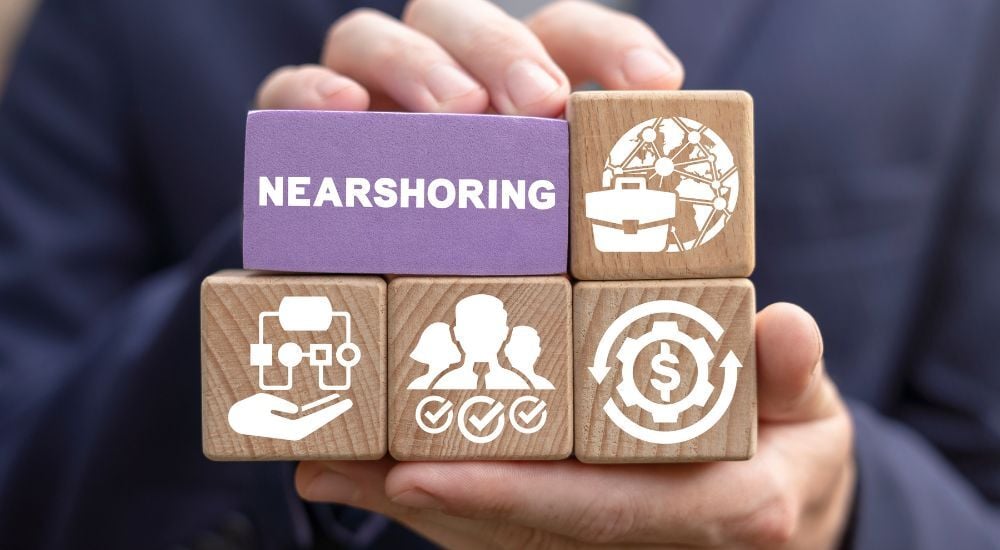How Artificial Intelligence is transforming nearshoring and the real estate market in Mexico
26/06/2025Nearshoring in Mexico has positioned the country as one of the top destinations for the relocation of industrial and logistics operations.
At the same time, Artificial Intelligence (AI) is emerging as a transformative force reshaping how industrial spaces are designed, built, managed, and marketed.
For example, according to a study by EY, companies that have implemented AI in key areas such as demand management, order processing, and logistics have improved forecasting accuracy by up to 70%.
AI is revolutionizing the entire value chain of the industrial real estate market, from portfolio planning to asset operations. By integrating these capabilities, companies can gain a decisive competitive edge in the evolving nearshoring landscape.
AI as a competitive advantage in industrial real estate
In a market where investment decisions must respond to increasingly dynamic variables, such as costs, energy, infrastructure, connectivity, talent, and future demand, AI enables more precise answers to key questions: What to build? Where? For whom?
James Scott, Director of the Real Estate Transformation Lab at MIT, told CREW Network that “AI has the potential to solve critical pain points the industry has been unable to change for decades.”
Thanks to machine learning models, developers can analyze millions of data points (land use, occupancy rates, logistics flows, wages, government incentives, etc.) to identify locations with the highest potential return.
Portfolio and site optimization
AI-powered platforms help evaluate the performance of multiple assets within a portfolio, recommending actions such as:
- Design upgrades
- Disposition of underutilized assets
- Relocation of projects to areas with better connectivity
They also enable the early identification of “hot zones” before they become saturated, supporting a first-mover advantage strategy in emerging industrial parks.
AI infrastructure demand as a market driver
The rapid expansion of artificial intelligence is not only transforming business processes, it is also generating a new category of real estate demand: data centers.
This trend presents a significant challenge for industrial space developers, particularly regarding energy capacity and technical infrastructure.
According to Goldman Sachs, global energy demand from data centers is expected to grow by 160% by 2030, driven primarily by intensive AI usage.

Why it matters for industrial real estate: This growing demand is attracting major players like Microsoft, AWS, and Google, driving up property values in logistics and tech corridors in northern Mexico and in states such as Guanajuato, Querétaro, and Hidalgo.
These regions are capitalizing on the trend with industrial parks like PILBA and PLATAH, which serve key sectors such as automotive, food, and chemicals.
📍 Explore our industrial parks in Mexico main industrial corridors and access flexible, industry-specific solutions.
Is the industrial real estate market ready for this evolution?
The integration of artificial intelligence into the real estate sector shows strong adoption potential. According to the CREW Network survey The State of AI in CRE 2024, the current landscape is as follows:
- Only 23% of companies in the sector are actively using AI tools.
- 55% are still evaluating how to implement them.
- Among those that have adopted the technology, 83% report improvements in operational efficiency.
- However, only 30% have clear policies in place regarding its use.

These figures reveal a latent opportunity. While AI is already being used to accelerate critical processes such as site evaluation and client acquisition strategies, there is still room for broader adoption.
How is AI being adopted in the sector?
The following chart, based on the same CREW Network study, shows the main uses of AI in the real estate market, highlighting data research (52%), marketing (46%), and content creation (41%) as the most common applications.
| How is AI being used in Commercial Real Estate (CRE)? | |
|
Research, data analysis |
52% |
|
Marketing, social media |
46% |
|
Content production, design, videos, graphics |
41% |
|
Review and quality control |
20% |
|
Sales (lead generation, CRM, etc.) |
14% |
|
Customer service / support |
14% |
|
Scheduling / productivity |
12% |
|
Other |
10% |
|
Property management |
6% |
|
In the hiring process |
5% |
|
Risk management |
5% |
Real estate professionals are using AI to detect trends, map high-growth industrial zones, and analyze absorption rates.
In terms of marketing and client acquisition, AI-powered platforms personalize lead generation strategies, segment prospects based on digital behavior, and optimize campaigns in real time.
AI as an accelerator in real estate development
AI analyzes variables such as land use, logistics costs, connectivity, future demand, and service availability to determine the best location for a warehouse, park, or logistics center.
Generative AI models can produce layouts, 3D renderings, and construction scenarios in minutes based on technical specifications, accelerating the design process and reducing the number of iterations.
Real-time financial and technical simulation
Tools like custom GPTs can estimate CAPEX, OPEX, and expected returns in seconds—integrating regional cost data, vacancy rates, rental prices, and logistics trends.
In the words of Spencer Burton from Stablewood: AI frees up talent to focus on higher-value strategic tasks. In five years, the role of the analyst in CRE will be completely different.
AI-powered solutions can also scan local and state regulations to validate compliance before investing in land or launching a BTS project.
Nearshoring + AI: A strategic combination
Nearshoring in Mexico has triggered a surge in demand for industrial parks, but AI enables predictive planning to guide that growth. This impacts:
- Park design: optimization of space, energy use, and logistics flows.
- Client prospecting: AI models identify companies most likely to nearshore based on shifts in their supply chains.
- Land valuation: computational models detect undervalued areas with high logistics potential.
In this way, artificial intelligence is redefining the rules of the game in the industrial real estate market.
Frontier Industrial: Your strategic partner for nearshoring in Mexico
Companies that adopt AI will not only be able to manufacture faster, but also smarter.
At Frontier Industrial, we support businesses and investors in unlocking the full potential of nearshoring through industrial real estate solutions tailored to your sector. Our portfolio includes everything from ready-to-develop land sales to Class A facility leases and Build-to-Suit projects.
With a strong presence in key regions such as Bajío, Monterrey, and Central Mexico, we deliver infrastructure aligned with the demands of new global supply chains.
Learn more about the impact of nearshoring to Mexico
You may also be interested in reading more about Nearshoring in Mexico 2025 and how to assess risks and make smart decisions.






